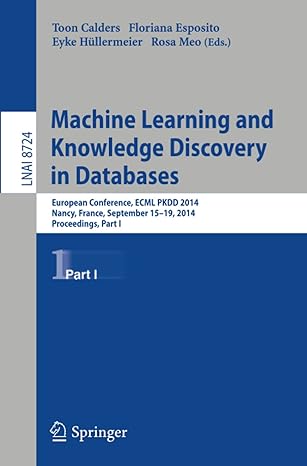Question
Case Project 1: Integration and Performance You have a PC with a 2 GHz processor, a system bus clocked at 400 MHz, and a 3
Case Project 1: Integration and Performance
You have a PC with a 2 GHz processor, a system bus clocked at 400 MHz, and a 3 Mbps internal cable modem attached to the system bus. No parity or other error-checking mechanisms are used. The modem has a 64-byte buffer. After it receives 64 bytes, it stops accepting data from the network and sends a data ready interrupt to the CPU.
When this interrupt is received, the CPU and OS perform the following actions:
- The supervisor is called.
- The supervisor calls the modems data ready interrupt handler.
- The interrupt handler sends a command to the modem, instructing it to copy its buffer content to main memory.
- The modem interrupt handler immediately returns control to the supervisor, without waiting for the copy operation to be complete
- The supervisor returns control to the process that was originally interrupted.
When the modem finishes the data transfer, it sends a transfer completed interrupt to the CPU and resumes accepting data from the network. In response to the interrupt, the CPU and OS perform the following actions:
- The supervisor is called.
- The supervisor calls the transfer completed interrupt handler.
- The interrupt handler determines whether a complete packet is present in memory. If so, it copies the packet to a memory region of the corresponding application program.
- The modem interrupt handler returns control to the supervisor.
- The supervisor returns control to the process that was originally interrupted.
Sending an interrupt requires one bus cycle. A push or pop operation consumes 30 CPU cycles. Incrementing the stack pointer and executing an unconditional branch instruction require one CPU cycle each. The supervisor consumes eight CPU cycles searching the interrupt table before calling an interrupt handler. The data ready interrupt handler consumes 50 CPU cycles before returning to the supervisor.
Incoming packets range in size from 64 bytes to 4096 bytes. The transfer complete interrupt handler consumes 30 CPU cycles before returning to the supervisor if it doesnt detect a complete packet in memory. If it does, it consumes 30 CPU cycles plus one cycle for each 8 bytes of the packet.
Question 1: How long does it take to move a 64-byte packet from its arrival at the modem until its receipt in the memory area of the target application program or service? State your answer in elapsed time (seconds or fractions of seconds)
Use the following table to determine how long it takes to move a 64-byte packet from its arrival at the modem until its receipt in the memory area of the target application program or service? State your answer in elapsed time (nanoseconds).
| Facts For Problem 1 | ||||
| Device | Clock rate (MHz) | Cycle time (ns) | Width (bytes) | Speed (bytes/sec) |
| Bus | 400 | 2.5 | 8 | |
| CPU | 2000 | 0.5 | 8 | |
| Modem buffer | 64 | |||
| Modem speed | 375000 | |||
| Operation | CPU Cycles | |||
| Push | 30 | |||
| Pop | 30 | |||
| Increment stack pointer | 1 | |||
| Branch | 1 | |||
| Supervisor lookup | 8 | |||
| Data ready interrupt handler | 50 | |||
| Transfer complete interrupt handler | 30 | |||
| Interrupt handler memory copy (8 bytes) | 1 |
Fill in CPU cycles and times:
| [5]CPU cycle time = |
|
| [5]Bus cycle time = |
|
| Processing steps | Bus or Cycle? | Cycles | Time (ns) |
| Send data ready interrupt to CPU |
| 1 | 2.5 |
| Call supervisor (PUSH+INCR+BRANCH) |
|
|
|
| Execute supervisor table lookup |
|
|
|
| Call interrupt handler (PUSH+INCR+BRANCH) |
|
|
|
| Execute data ready interrupt handler |
|
|
|
| Return to supervisor (POP) |
|
|
|
| Return to suspended program (POP) |
|
|
|
| Transfer buffer content (64 bytes) across bus Note: This occurs simultaneously as the return to supervisor. Since the time taken is less than the time needed for the return, it doesn't count towards the total time. |
|
|
|
| Send transfer completed interrupt to CPU |
|
|
|
| Call supervisor (PUSH+INCR+BRANCH) |
|
|
|
| Execute supervisor lookup |
|
|
|
| Call interrupt handler (PUSH+INCR+BRANCH) |
|
|
|
| Execute transfer complete interrupt handler |
|
|
|
| Interrupt handler memory copy (64 bytes) |
|
|
|
| Return to supervisor (POP) |
|
|
|
| Return to suspended program (POP) |
|
|
|
| [4]Sum |
|
| [5]Total CPU Cycles = |
|
| [5]Total Bus Cycles = |
|
Step by Step Solution
There are 3 Steps involved in it
Step: 1

Get Instant Access to Expert-Tailored Solutions
See step-by-step solutions with expert insights and AI powered tools for academic success
Step: 2

Step: 3

Ace Your Homework with AI
Get the answers you need in no time with our AI-driven, step-by-step assistance
Get Started


